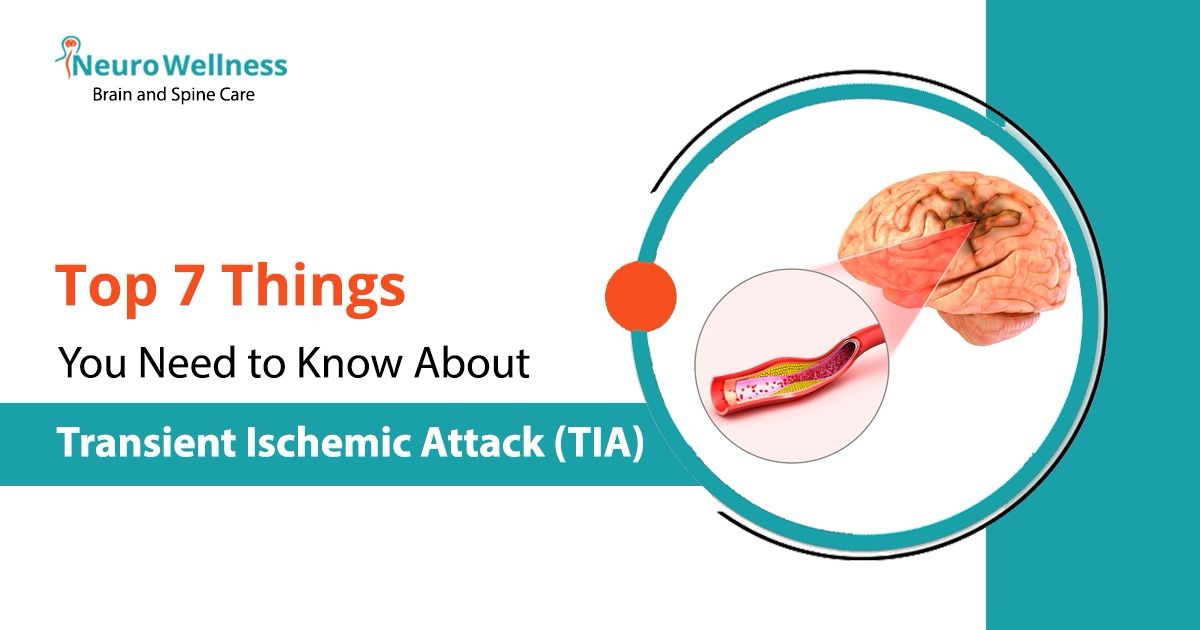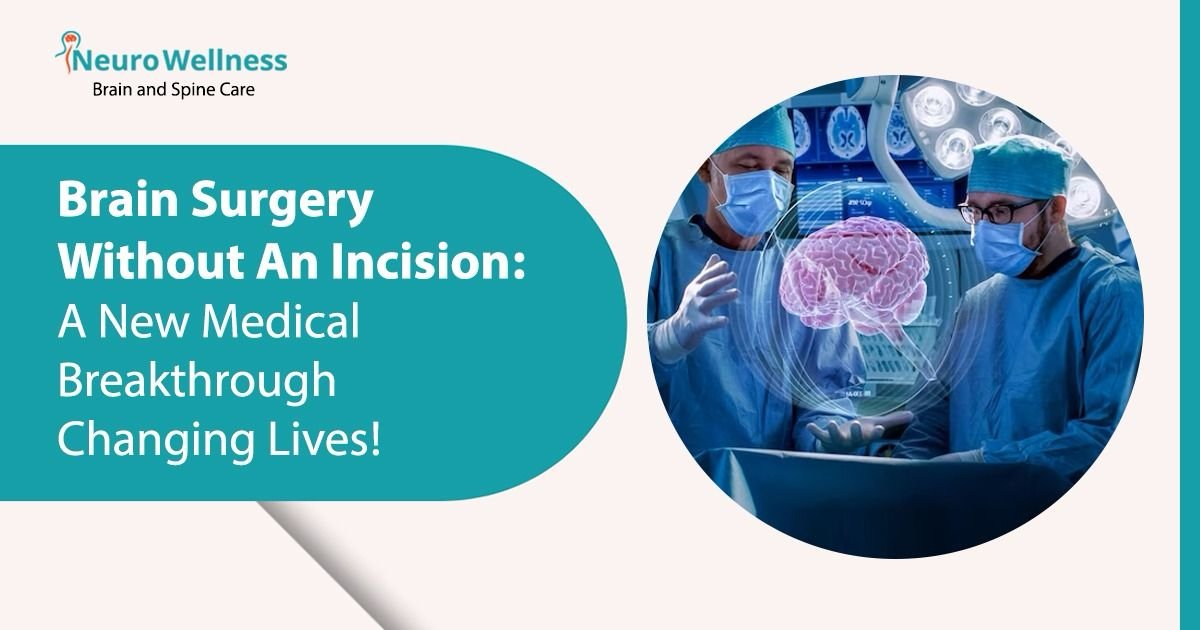Introduction:
Imagine your brain sending you a quick alert that something is amiss – that’s what a Transient Ischemic Attack (TIA) feels like. Often called a “mini-stroke,” a TIA is more than just a fleeting experience; it’s a critical warning of potential future health risks.
In this detailed guide, we’ll uncover 7 key facts about TIAs that everyone should know.
We’ll simplify complex terms like TIA symptoms, TIA treatment, and what makes this condition so important to address promptly.

Dr. Ganesh Veerabhadraiah
Consultant – Neurosurgeon, Neurointerventional Surgery, Spine Surgeon (Neuro)
23+ Years Experience Overall (17+ years as Neuro Specialist)
Available for Consultation: Jayanagar 9th Block & Kauvery Hospital, Electronic City
What is a Transient Ischemic Attack?
A Transient Ischemic Attack (TIA), often referred to as a mini-stroke, occurs when there’s a temporary blockage of blood flow to the brain.
This results in a brief lack of oxygen, causing stroke-like symptoms that typically resolve within 24 hours.
The medical abbreviation for TIA stands for “Transient Ischemic Attack.”
Key Characteristics of a TIA:
▪️ Symptoms appear suddenly and last for a few minutes to several hours.
▪️ No permanent brain damage occurs, unlike in a full-blown stroke.
▪️TIAs often signal an underlying issue, like blocked arteries or irregular blood flow.
Understanding TIA symptoms and seeking immediate care is critical for preventing major strokes. Let’s explore why these mini-strokes demand attention.
Why Transient Ischemic Attacks (TIAs) or Mini-Strokes Are a Big Deal?
TIAs are not just harmless episodes. Recognizing and addressing them can prevent more serious medical events. Here’s why: Numbness or weakness in the face, arm, or leg, often on one side of the body.
Difficulty with speech, such as slurring or trouble understanding others. Vision problems, including sudden blindness in one or both eyes. Dizziness, loss of balance, or coordination issues.
Confusion and sudden, severe headaches. If these symptoms occur, assume it’s an emergency. Even if the signs vanish quickly, they could point to a more significant issue.
Common symptoms of a transient ischemic attack (TIA) include:
1. Numbness or weakness in the face, arm, or leg, especially on one side of the body
2. Trouble seeing in one or both eyes
3. Difficulty with walking, dizziness
4.Confusion or difficulty in talking or understanding speech
5. Loss of balance and coordination
6. Lack of control over the bladder or bowels
Read Similar Topics : From Treatment to Triumph: Physical Recovery after Brain Tumor
How Long Does a TIA Last?
How Long Does a TIA Last?
A TIA typically lasts only a few minutes but can extend to a couple of hours. Symptoms resolve entirely within 24 hours.
Key Insight
Although the effects of a TIA are temporary, the underlying cause remains. Without addressing the root issue, the risk of a major stroke increases significantly.
What Are the Causes of a Transient Ischemic Attack?
The most common cause of a TIA is blood clots.
When a clot forms in an artery connected to the brain, it restricts blood flow, depriving the brain of essential oxygen for proper functioning.
These clots are typically temporary and get reabsorbed quickly, restoring normal blood flow.
Occasionally, factors such as fatty material (plaque) in the artery or an air bubble can trigger a mini stroke. In rare cases, a small amount of bleeding in the brain (hemorrhage) may also be a cause.
Key Risk Factors:
• High blood pressure (hypertension)
• High cholesterol
• Smoking
• Diabetes
• Irregular heartbeat (atrial fibrillation)
• Age (risk increases after 55)
What are the Risk Factors of TIAs?
Primary Risk Factor: High Blood Pressure (Hypertension) is a significant contributor to TIAs.
Other Significant Risk Factors:
1.Irregular heartbeat (atrial fibrillation)
2.Diabetes
3.Family history of stroke
4.High cholesterol
5.Abnormal blood clotting
6.Increasing age, especially after 55
7.Smoking
8.Alcohol use
9.Recreational drug use
10.Irregular heartbeat (atrial fibrillation)
11.Diabetes
12.Family history of stroke
13.High cholesterol
14.Abnormal blood clotting
15.Increasing age, especially after 55
16.Smoking
17.Alcohol use
18.Recreational drug use
What Happens After a TIA?
While a TIA doesn’t cause lasting brain damage, it’s a wake-up call. Many people experience heightened anxiety and stress following an episode, which can impact mental well-being.
Post-TIA Care Includes:
Consulting with a neurologist to identify the cause.
Regular follow-ups and lifestyle adjustments to reduce stroke risks.
Mental health support is equally vital. Talking to healthcare professionals or support groups can alleviate stress and promote recovery.
Treatment for TIAs: What You Need to Know
Prompt treatment is essential to prevent future TIAs or a full stroke. Here’s what you can expect:
1.Diagnosis
• Physical and neurological exams.
• Imaging tests like CT, MRI, or carotid ultrasonography to detect blockages.
• Blood tests to identify clotting issues.
2. Medical Interventions
• Medications: Antiplatelet drugs, anticoagulants, and statins.
• Surgery: Procedures like carotid endarterectomy to clear blocked arteries.
Lifestyle Changes:
ㆍ Maintaining a healthy diet.
ㆍ Regular physical activity.
ㆍ Quitting smoking and limiting alcohol intake.
Preventing a transient ischaemic attack (TIA)
Having a transient ischaemic attack (TIA) means you have a higher chance of more TIAs or a serious stroke. But, regardless of whether you’ve had a TIA or stroke before, making certain lifestyle changes can greatly reduce this risk.
Here’s what you can do:
- Keep a healthy weight
- Eat a balanced and nutritious diet
- Exercise regularly
- Limit alcohol
- Quit smoking
Now that we’ve covered the basics of Transient Ischemic Attacks (TIAs), let’s dive into the seven facts you need to know to stay informed and empowered about your health.
Top 7 Facts You Need to Know About TIAs
1. A TIA is a warning sign of a future stroke.
TIAs start suddenly and last briefly (1-2 hours), signaling potential future stroke risks.
About one in three people who experience a TIA will have a stroke, and roughly half of these strokes happen within a year after the TIA.
The American Stroke Association confirms that 9 to 17% of people who have had a TIA experience a stroke within 90 days. Seeking proper care can significantly reduce this risk.
2. Use F.A.S.T. for TIA symptoms; call medical emergency even if brief.
Time lost is brain lost. Remember FAST:
- F – Face drooping
- A – Arm weakness
- S – Speech difficulty
- T – Time to call ambulance/doctor
3. No driving post-TIA.
You should not drive for 2 weeks after a TIA. If you have a commercial driving license, you shouldn’t drive for 4 weeks at least.
4. Urgently seek medical help for all stroke-like symptoms.
Because there is no way to tell whether symptoms are from a TIA or an acute stroke, you should assume that all stroke-like symptoms signal an emergency and should not wait to see if they go away.
A prompt evaluation (within 60 minutes) is necessary to identify the cause of the TIA and determine appropriate therapy.
5. A TIA leaves no permanent brain damage.
A TIA looks and feels like a stroke but doesn’t cause permanent damage. Similar to a stroke, it happens when a blood vessel blockage interrupts brain blood flow. However, TIA symptoms vanish within 24 hours, often faster, and don’t result in lasting brain damage.
6. Transient Ischemic Attacks (TIAs) cases are not rare.
Transient Ischemic Attacks (TIAs) are quite common and treatable by medical experts, with more than 1 million cases per year (India).
7. Mini-Strokes Aren't "Mini"
TIAs are often misunderstood due to their temporary nature and lack of lasting evidence on scans.
Despite being known as “mini-strokes,” they should be considered warning strokes, requiring immediate medical attention to prevent future, more severe strokes.
If stroke-like symptoms arise, treat them urgently and remember: time lost is brain lost.
When to Contact a Doctor?
Wondering when to contact a medical professional about a possible TIA (Transient Ischemic Attack)? Don’t hesitate—act fast!
A TIA is a medical emergency! Even if symptoms vanish, they could be a warning sign of a future stroke.
If you experience TIA symptoms, act fast. Early intervention can save lives. Contact specialized clinics like NeuroWellness in Bangalore for expert care.
Don't Ignore TIA Symptoms!
TIAs can mimic other neurological issues, making a detailed evaluation by a doctor crucial.
Since TIAs often precede strokes by hours or days, seeking immediate medical attention after a possible TIA is necessary. If you suspect a TIA, get help ASAP. Swift evaluation can identify treatable conditions and possibly prevent a stroke.
If you are looking for expert stroke treatment in Bangalore, reach out to us for immediate care!
Get On the Road to Recovery
At NeuroWellness, we understand the urgency and complexity surrounding health care. Our team of experienced neurosurgeons employs state-of-the-art techniques to ensure precise diagnosis and effective treatment.
By choosing NeuroWellness, you’re opting for a holistic and advanced stroke treatment in Bangalore that prioritizes your well-being.
Find out more
A transient ischemic attack (TIA) can happen unexpectedly, leaving behind confusion and fear. If you are looking for more information, get in touch with our medical experts.
Get Expert Care at NeuroWellness
At NeuroWellness, our experienced neurosurgeons provide comprehensive care for TIAs and strokes. Using advanced diagnostics and treatments, we help patients recover and prevent future episodes. Reach out today to start your journey toward better health.
Our team can answer your questions about TIA and help you get your health on the right track! Get help now!
You May also see Videos
FAQs About TIA (Mini Stroke)
1. Is a TIA a real stroke?
A TIA is often called a “mini-stroke” because it has similar symptoms but no lasting damage. It’s a major warning sign of a future stroke.
2. What are the first signs of a TIA?
Sudden confusion, trouble speaking, weakness on one side, or vision changes are common early signs.
3. How is TIA treated in Bangalore?
Treatment typically includes blood thinners, lifestyle changes, and in some cases, surgery. Immediate medical attention is key.
4. Can a TIA go away on its own?
Yes, symptoms often disappear within minutes or hours, but medical evaluation is still urgent.


